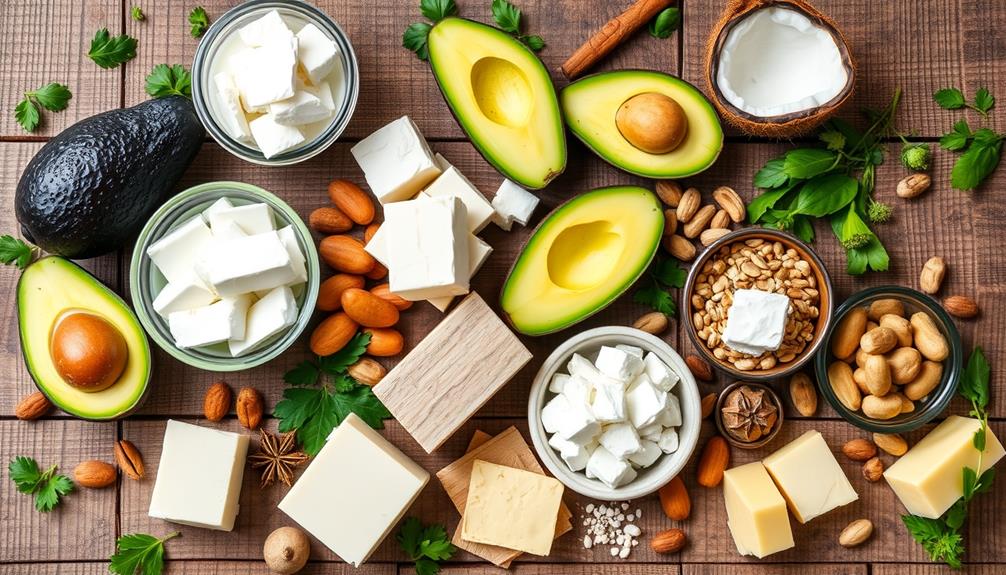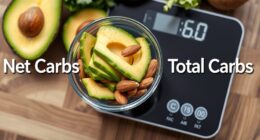To add fat to your keto diet, focus on incorporating healthy sources like avocados, fatty fish, nuts, and coconut oil. Use these in smoothies or salads, and try snacking on nut butter or seeds. Adding oils, like olive oil or avocado oil, to your cooking or dressings ramps up the fat content while enhancing flavor. Consider bulletproof coffee for a creamy morning boost. For creative indulgence, whip up fat bombs with coconut oil and cream cheese. Explore more ideas and techniques to make your keto journey even more delicious and satisfying. Additionally, consider incorporating MCT oil into your diet for its quick energy-boosting properties. Another great way to increase your fat intake is by using keto diet pill benefits that can help support your body’s transition into ketosis and provide an extra boost of fat-burning power. By focusing on these healthy fats and incorporating them into your meals, you can make your keto journey even more enjoyable and effective.
Key Takeaways
- Incorporate avocado into meals or snacks, providing 15 grams of healthy monounsaturated fats per medium avocado.
- Use high-quality oils like olive oil and coconut oil for cooking, enhancing flavor while adding healthy fats.
- Add nuts and seeds to snacks or salads for a convenient source of 14-25 grams of fats per ounce.
- Blend smoothies with nut butters or MCT oil to significantly increase fat content and improve texture.
- Create fat bombs using coconut oil, cream cheese, and cocoa powder for a tasty treat with 9-12 grams of fat per serving.
Understanding Healthy Fats

When you're diving into a ketogenic diet, understanding healthy fats is vital for your success. Healthy fats should make up about 70-80% of your daily caloric intake to maintain ketosis and keep your energy levels high.
Start by focusing on unsaturated fats, particularly monounsaturated fats found in avocados and olive oil. These fats are linked to lower mortality rates and better heart health, while also being rich in antioxidants that can aid overall wellness like cranberry juice consumption.
While saturated fats were once frowned upon, they're now considered acceptable in moderation on a keto diet. Sources like coconut oil and grass-fed butter can provide the energy you need without derailing your progress.
Don't forget about polyunsaturated fats, especially omega-3 fatty acids from fatty fish and flaxseeds. These play an important role in reducing inflammation and supporting overall wellness.
However, it's essential to minimize trans fats, commonly found in processed foods. They're linked to a higher risk of heart disease and offer no nutritional benefits.
Top Sources of Fats
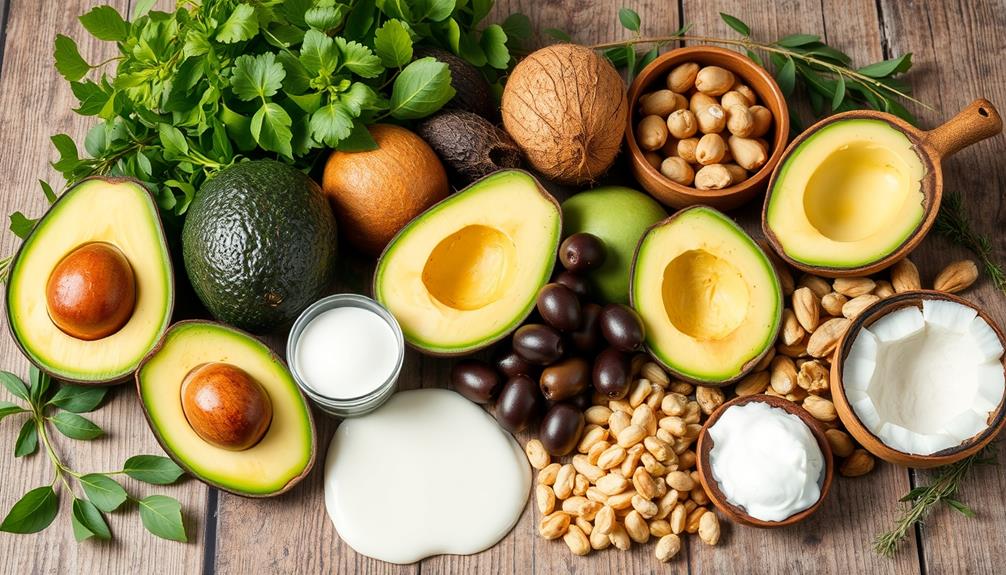
Incorporating the right sources of fats into your ketogenic diet is key to achieving and maintaining ketosis. A balanced diet rich in healthy fats can enhance overall health and well-being, making the right choices essential.
One of the best options is avocado oil, packed with heart-healthy monounsaturated fats. You'll get about 15 grams of fat from a medium avocado, plus fiber and essential nutrients.
Fatty fish like salmon, mackerel, and sardines are also fantastic, offering 13-20 grams of omega-3 fatty acids per 3-ounce serving, which support heart health and combat inflammation. Regular consumption of these fats can contribute to lifestyle for longevity as well.
Don't overlook nuts and seeds; they're nutrient-dense and provide around 14-25 grams of healthy fats per ounce. Think walnuts, almonds, or chia seeds for a great snack.
Coconut oil is another excellent choice, containing medium-chain triglycerides (MCTs) that your body metabolizes quickly for energy. With about 14 grams of fat per tablespoon, it's a great addition.
Ways to Incorporate Fats
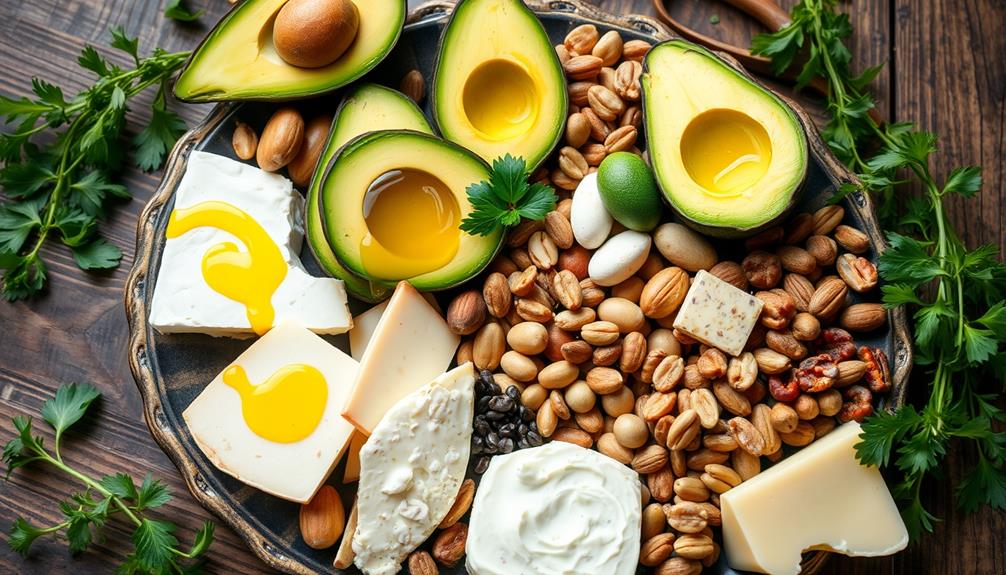
Adding healthy fats to your meals can transform your ketogenic diet into a satisfying and flavorful experience. Start your day with bulletproof coffee by blending butter or coconut oil into your hot coffee for a creamy boost.
You can also enhance your smoothies with avocado, nut butters, or MCT oil, which not only increases fat content but also adds a rich texture. Additionally, incorporating natural remedies can further enhance your overall well-being during your keto journey.
When it comes to salads, opt for high-fat dressings made from olive oil or full-fat dairy to make them more enjoyable while keeping your meals nutritious.
For snacks, munch on nuts and seeds like walnuts, almonds, or pumpkin seeds; they're packed with healthy fats and essential nutrients.
You can also prepare fat bombs using ingredients like cream cheese, nut butters, and coconut oil. These convenient snacks help you hit your daily fat goals without much effort.
Cooking Techniques for Fat

When you're cooking on a keto diet, utilizing healthy oils for sautéing can elevate the flavor and boost your fat intake.
Incorporating ingredients like avocado oil or coconut oil can provide additional health benefits, as both oils are high in healthy fats and can enhance the overall taste of your meals.
Baking with sources like butter or full-fat dairy adds richness to your dishes, while drizzling homemade dressings enhances both taste and fat content.
Herbal teas like chamomile and ginger may also help with relaxation after a heavy meal, making it easier to unwind.
Let's explore these techniques to maximize your fat consumption effectively.
Sautéing With Healthy Oils
Sautéing with healthy oils is a fantastic way to enhance the flavor of your meals while boosting your intake of beneficial fats. When you choose oils like olive oil or avocado oil, you're not only adding rich flavors but also heart-healthy monounsaturated fats that support overall health.
Using oils with high smoke points, such as avocado oil (around 520°F), helps maintain their nutritional integrity and prevents harmful compounds from forming during cooking. Incorporating fats while sautéing vegetables can increase the absorption of essential fat-soluble vitamins (A, D, E, K), maximizing the nutritional benefits of your meals.
For an extra flavor kick, consider mixing oils. Combining olive oil with butter creates a rich taste while aligning with your keto diet goals. Additionally, including oils rich in omega-3 fatty acids, like flaxseed oil (ideal for low-heat applications), diversifies your healthy fat profile.
| Oil Type | Key Benefits |
|---|---|
| Olive Oil | Rich in monounsaturated fats |
| Avocado Oil | High smoke point, heart-healthy |
| Flaxseed Oil | Source of omega-3 fatty acids |
Baking With Fat Sources
Baking offers a unique opportunity to incorporate healthy fats into your meals while satisfying your cravings for delicious treats. You can easily swap traditional oils for coconut oil or butter, enhancing flavor and keeping carb counts low.
When it comes to flour, consider experimenting with almond flour or coconut flour; these options aren't only lower in carbohydrates, but they also add healthy fats to your baked goods. Additionally, using essential oils like peppermint oil can add a revitalizing twist to your recipes, providing not only flavor but also potential health benefits.
Using full-fat dairy products, like cream cheese or sour cream, can add moisture and richness, resulting in a denser, more satisfying texture.
Don't forget to enhance the fat content of your treats by incorporating nut butters, such as almond or peanut butter. These nut butters provide both flavor and healthy monounsaturated fats, making your baked creations even more delicious.
For an extra nutritional boost, think about adding chia seeds or flaxseed to your recipes. Not only do these seeds contribute healthy fats, but they also help bind ingredients together, improving the overall texture and nutritional value of your baked goods.
With these fat sources, you can enjoy rich, satisfying treats while sticking to your low-carbohydrate lifestyle.
Dressing and Drizzling Techniques
Dressing and drizzling techniques can transform your meals by adding essential healthy fats that enhance flavor and texture. Start by using high-fat dressings, like homemade mayonnaise or avocado oil-based vinaigrettes, to elevate your salads and low-carb vegetables with rich flavors.
Butter, a great source of vitamins A, D, E, and K, can be melted and drizzled over dishes for added richness and moisture, making it a versatile option in these techniques butter is a dairy product. Drizzle olive oil over roasted vegetables or grilled meats for a savory touch that boosts fat content.
Incorporate heavy cream or full-fat sour cream into your sauces to create a creamy texture and add fat. This works wonders in dishes like chicken Alfredo or creamy soups.
For a sweet twist, add nut butters, such as almond or peanut butter, to smoothies or desserts to increase healthy fat intake while delivering a satisfying flavor profile.
Don't forget to top your meals with seeds like pumpkin or chia seeds. They not only add a delightful crunch but also enhance the healthy fat content, making your meals more nutrient-dense.
Snack Ideas for Keto
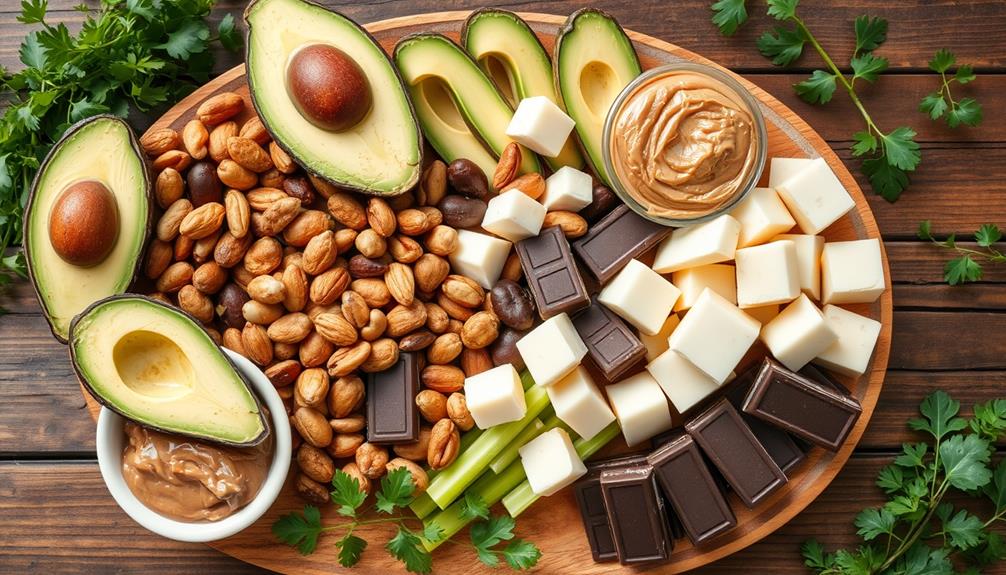
When you're following a keto diet, finding satisfying snacks that boost your fat intake is essential. One great option is to incorporate nut butter, like almond or macadamia, into your snacks. Just one tablespoon packs about 8-10 grams of healthy fats.
You can also enjoy full-fat cheeses, such as cheddar or gouda, paired with low-carb crackers, giving you around 7 grams of fat per ounce. Exploring various brewing methods can also inspire flavorful pairing ideas that complement your keto snacks.
Avocado slices are another fantastic choice; a medium avocado offers a whopping 15 grams of monounsaturated fats. If you're looking for something quick, grab a handful of olives, which provide about 4-5 grams of healthy fats per serving and are low in carbs.
For a sweet treat, consider making fat bombs using coconut oil, cream cheese, and cocoa powder. These little bites aren't only delicious but also deliver around 9-12 grams of fat per serving.
With these snack ideas, you can easily maintain your keto lifestyle while enjoying satisfying, flavorful options that contribute to your daily fat intake.
Meal Planning for Fat Intake

Effective meal planning is key to guaranteeing you hit your fat intake goals on a keto diet. To achieve the recommended fat intake of about 70-80% of your daily calories, focus on high-fat ingredients like avocados, nuts, and fatty cuts of meat.
Incorporating healthy fats into every meal by using dressings made from olive oil or avocado oil can enhance flavor and provide essential nutrients. Additionally, consider exploring essential oils for skin conditions that may complement your overall wellness while following a keto lifestyle. You can also add butter or coconut oil to your hot beverages for an extra boost.
Creating a meal prep schedule is essential. Plan ahead with fat-rich recipes such as creamy soups, sauces using full-fat dairy, and keto fat bombs for convenient snacks. This approach guarantees a steady intake of healthy fats throughout the week.
Don't forget to utilize various cooking methods, like roasting vegetables in olive oil or tossing nuts and seeds into salads to enhance flavor and increase fat content.
Frequently Asked Questions
How Do I Increase My Fat on Keto?
To increase your fat intake on keto, add healthy oils to your meals, snack on nuts, and enjoy full-fat dairy. Consider blending butter into coffee or making fat bombs for convenient, delicious options throughout the day.
What Is the Best Source of Fat for Keto?
When it comes to finding the golden ticket to healthy fats on keto, you can't go wrong with oily fish, avocados, or coconut oil. They'll elevate your meals and keep your body thriving.
What Happens if I Don't Eat Enough Fat on Keto?
If you don't eat enough fat on keto, you'll likely feel hungrier, have low energy, and struggle to maintain ketosis. It can also lead to nutrient deficiencies and unstable blood sugar levels, affecting your overall health.
What Food Has Fat but No Carbs?
Envision this: you're on a treasure hunt for foods with fat but no carbs. Look for oils like olive and coconut, butter, fatty meats, full-fat dairy, and nuts—each delivers healthy fats without the carbs!
Conclusion
Incorporating healthy fats into your keto diet doesn't have to be intimidating. By understanding the benefits of fats and exploring various sources, you can easily enhance your meals while enjoying the flavors. Cooking techniques and snack ideas can make your journey delicious and satisfying. Remember, the key is balance; too much can hinder your progress, but the right amount supports your keto goals. Embrace the fats, and you might just find yourself loving this lifestyle even more!
